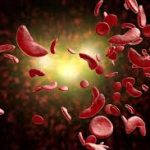
Dr. Maxwell Nartey
Professor of Symptometric Science, American School of Symptometry, NFP
World Center for Health Education & Scientific Enlightenment
Overheating should never be confused with hot flashes.
Hot flashes
Hot flashes are caused by an abundance of progesterone and a shortage of estrogens, and it is the absence of HDL that causes this imbalance. Why does an abundance of progesterone cause the body to overheat, and the sweat glands to overproduce sweat? Here is the answer.
The woman’s body is overheating because each molecule of progesterone releases 21 atoms of carbon and 30 atoms of hydrogen. Multiply this by 30 to 40 molecules of progesterone, and one will understand why heat is overwhelming the woman.
However, if the woman can produce a lot more estrogens to counterbalance the amount of heat that progesterone is releasing, her sweat glands will not be overtaxed. As a result, her hypothalamus whose ductless openings are not glued shut, will be able to distribute heat evenly throughout her body. This is how the body’s cooling mechanism works.
The hypothalamus also serves as our natural thermostat, but we must know how to keep it functioning decade after decade so that it works for us.
Women who do not deplete their estrogens and have the ductless opening of their hypothalamus wide open, will not have hot flashes. Therefore, not all women in their 30s, 40s or 50s have hot flashes.
Some women have congested sweat glands, others do not. The heat-regulating section of the hypothalamus in certain women is glued shut. Other women do not have this problem. Then, there are women who deplete their estrogens, but they do not know how to help their ovaries, skin, uterus and breasts to produce estrogens.
To prevent hot flashes or to put a stop to them, a woman should not eat the food sources of mucilage, she should hydrolyze the concretions that are in her sweat glands; and she should supply her body between 1,200 mg and 1,400 mg of HDL every day. This will prevent the overproduction of inhibin. It is inhibin that blocks the hypothalamus’ effort to regulate body temperature.
Overheating
Overheating is caused by congested sweat glands and a hypothalamus that cannot release glycoproteins to regulate body heat; and this is because the section that regulates body heat is glued shut.
If individuals who cannot sweat are overheating, they have no cooling mechanism to cool them down. They may continue to overheat until they die of heatstroke, or until they become unconscious.
Taking Evening primrose oil for hot flashes is a complete joke.
If a woman overheats, and she sweats profusely for say, three hours, then, she feels cold, it is a strong indication that her hypothalamus is broken. It must be repaired.
The sweating controversy
Does sweating help to purify blood? This is a myth. No, it does not. Excessive sweating rather removes a lot of water, and the cations of mineral salts from the person’s eleven systems. How will these salts be replaced? Mineral salts are not cooking salt; and drinking water to so-called “rehydrate” will not necessarily restore water to the cells. It is osmosis that restores water to the cells. Has the person’s osmosis mechanism been repaired?
If a person does not know what it takes to produce mineral salts for his or her tissues, they will have degenerative diseases. This is because the crosslinks that bind collagen and the matrix are made with mineral salts, HDL, water, and lysyl oxidase.
© Copyright 2021, The American School of Symptometry, NFP. No part of this publication may be reproduced or transmitted in any form or by any means, electronic or mechanical, including photocopying, recording, or by any information storage and retrieval system without the written permission of The American School of Symptometry, NFP. Library of Congress copyright number Txu 1-621-370, Washington D.C.


 Previous Post
Previous Post Next Post
Next Post